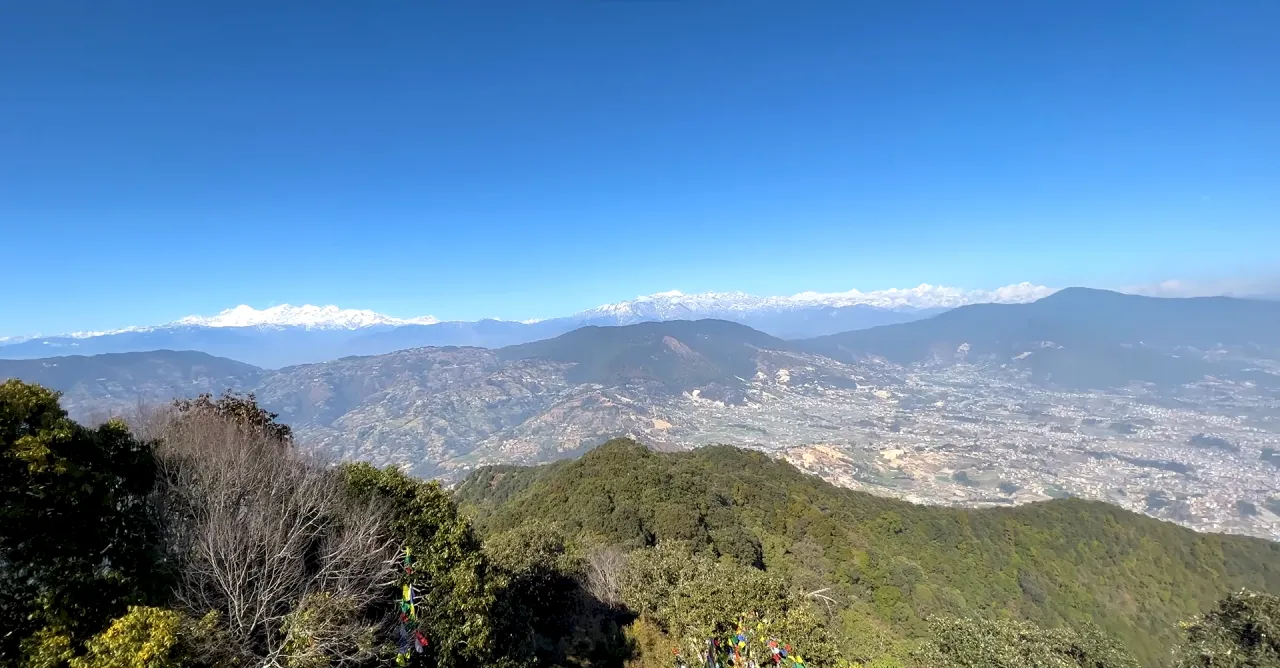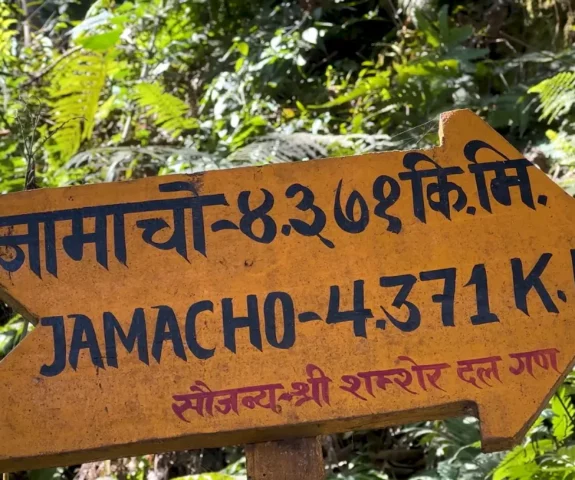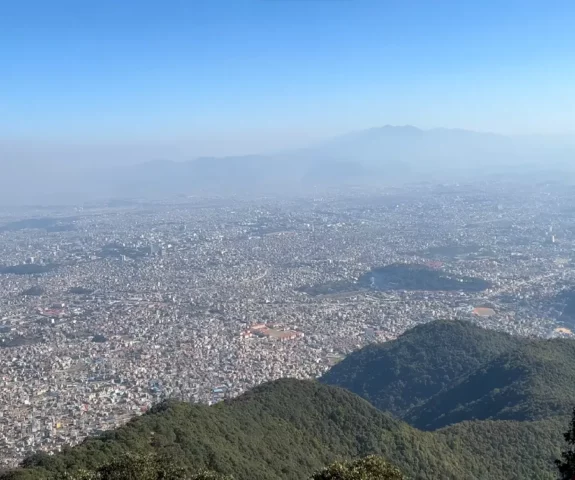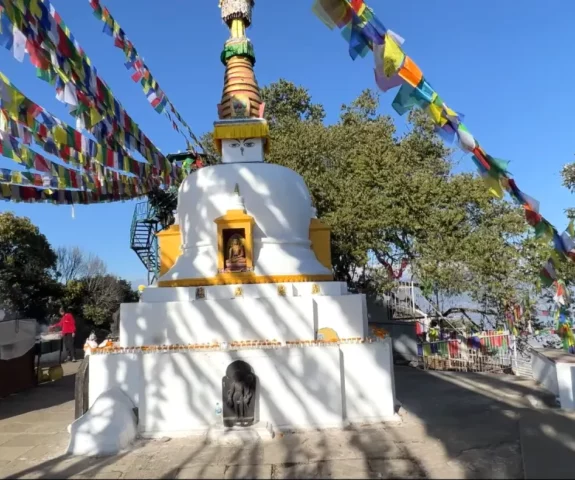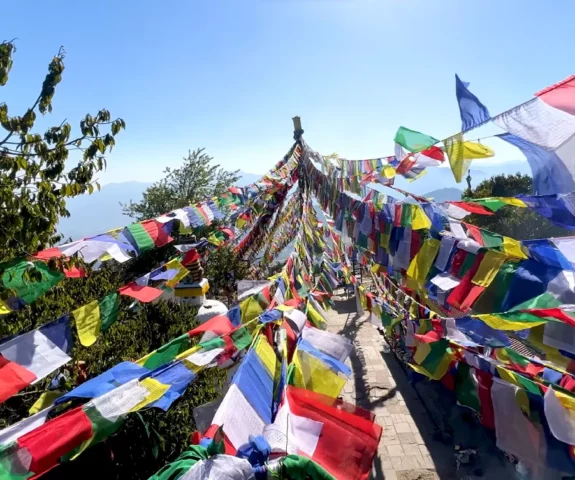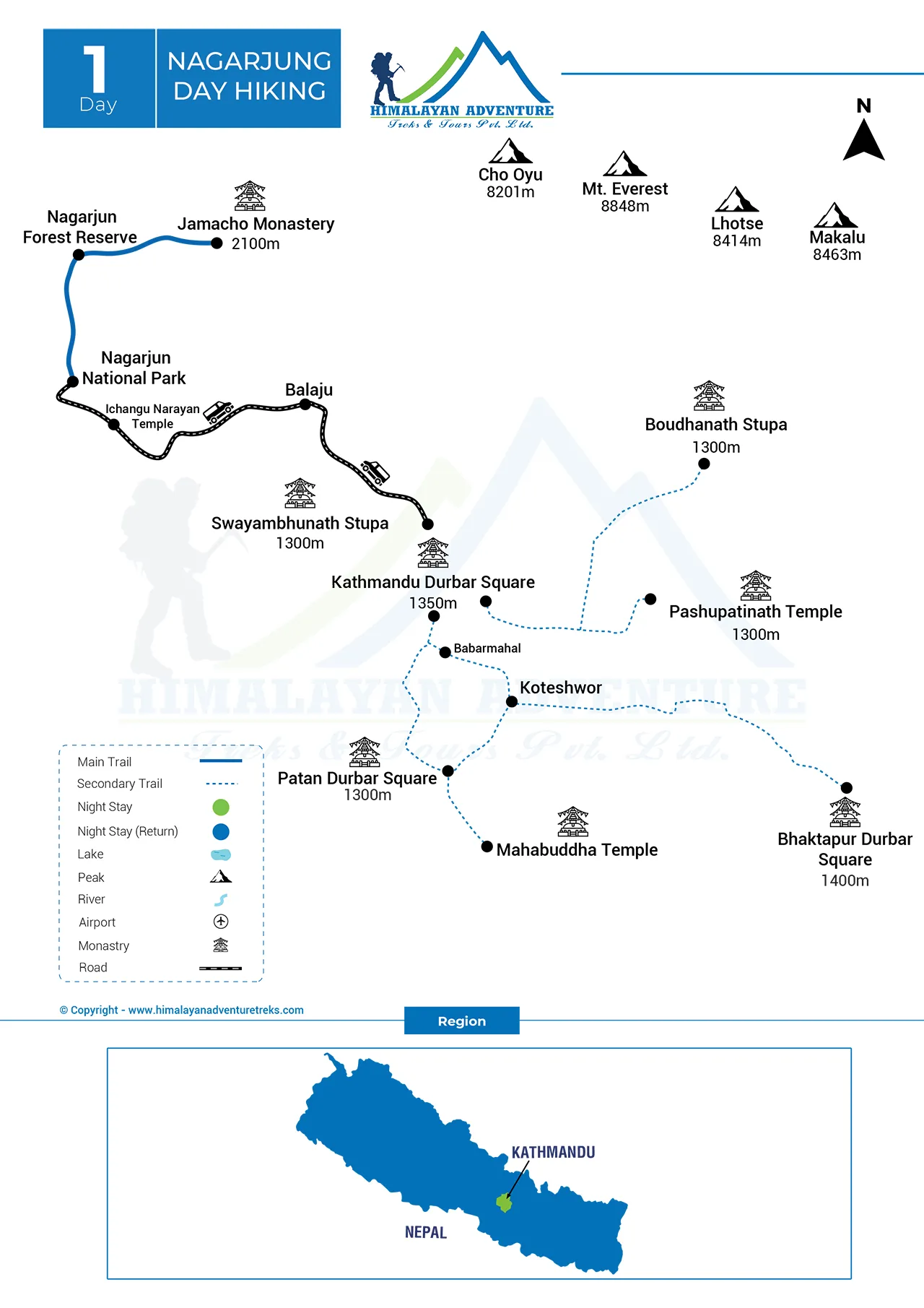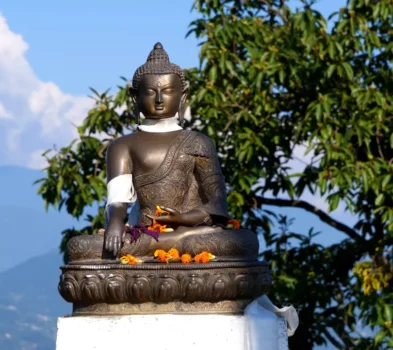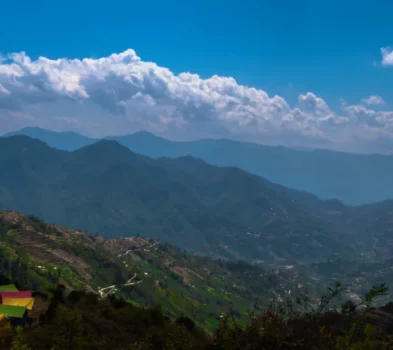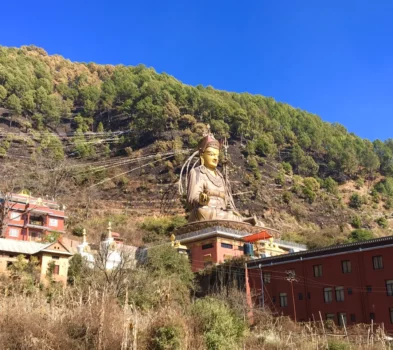Duration
1 DayNagarjung Day Hiking
Trip Grade
EasyGroup Size
1-16 PeopleMax Altitude
2,128m. / 6,982ft.Best Season
Feb- May/ Sept- NovActivity
Day HikingTransportation
Private VehicleTrip Customization
On request (click here)Highlights of Nagarjung Day Hiking
- You get to explore the rustic side of Kathmandu Valley.
- The Langtang range offers breathtaking views.
- The panoramic scenes of the Kathmandu valley are exclusive to this hike only.
Trip Introduction
Nagarjung Day Hiking is probably the most popular hiking route around the Kathmandu Valley. The easy and gentle route with picturesque views is what attracts people every year. Along with the view of the Kathmandu Valley, you can also enjoy the Langtang and Jugal ranges. The hike also explores the esteemed Jamacho Monastery, which sits at the top of Nagarjung Hill. All in all, the Nagarjung Day Hiking is an introduction to the natural and cultural beauty of the hill station to the north of Kathmandu.
Firstly, the Nagarjung Day Hiking Trip begins from Kathmandu with a drive to Budhanilkantha Temple. You can also explore the Hindu temple premises, which is also the starting point on the hike. The hike starts with a gradual ascent and gets fairly steep on a few sections of the hike. You will continue through lush forests within the Shivapuri National Park. Also, you can see a wide variety of flora and fauna that reside within the national park. Following the well-made trails, you reach the top of the hill. Then, you can rest and savor the views. The hilltop offers beautiful vistas of the Langtang, Jugal, and Ganesh Himal ranges. You can also explore the Jamacho Monastery before returning to the Budhanilkantha temple.
It is one of the hiking routes around the capital city that you can enjoy with your family and friends. So, you can have an average physical condition to do the hike. Likewise, you can also extend the hike to Dhulikhel if you want to have more adventure. You can do this hike any time of the year, but it is best to avoid the rainy season.
About us
Himalayan Adventure Treks offers you the best accommodation, transportation, and miscellaneous facilities as per your needs. Along with it, we also have qualified and friendly guides who you can easily warm up to. You can also adjust your trip schedules as you wish.
Outline Itinerary of Nagarjung Day Hiking
Day 01: Jamacho Monastery Hike – A Scenic Day Excursion Near Kathmandu.
Our guests sharing their experiences (Photo/Video Gallery)
Detail itinerary of Nagarjung Day Hiking
Day 01: Jamacho Monastery Hike – A Scenic Day Excursion Near Kathmandu.
Morning Start: Preparing for the Hike:
Your day begins at 7:00 AM as you wake up and get ready for an adventurous excursion to Jamacho Monastery. This is one of the best short hikes near Kathmandu, offering a blend of nature, culture, and breathtaking views of the Kathmandu Valley and the Langtang Himalayan range.
At 7:30 AM, enjoy a hearty breakfast at your hotel. A good meal is essential to fuel your body for the hike ahead, as the journey involves a steep ascent through the lush Nagarjun forest. Make sure to carry enough water, some light snacks, a camera, and comfortable hiking shoes for a smooth and enjoyable experience.
Drive to the Hiking Start Point:
At 8:00 AM, board your private vehicle for a short drive towards Balaju, a key intersection in Kathmandu. From here, the journey continues towards the Nagarjun Forest Reserve, located on the western outskirts of Kathmandu. The drive takes approximately 30 minutes, leading you to the entrance of Shivapuri Nagarjun National Park, where you will begin your hike.
Upon arrival at the national park, you may need to register and obtain an entry permit before starting the trek. The hike begins at an altitude of approximately 1,500 meters (4,921 feet), gradually ascending towards the Jamacho viewpoint.
Hiking Through Nagarjun Forest:
At 8:30 AM, start your ascent through the dense and tranquil forest. The trail is well-defined but can be steep in certain sections. The climb takes around 4 hours, covering a distance of approximately 5-6 km (3.1-3.7 miles) with an elevation gain of over 800 meters (2,624 feet).
The hike offers an immersive experience in nature, as you walk under a canopy of tall trees, listening to the sounds of birds chirping and feeling the fresh mountain breeze. Along the way, you may encounter various species of flora and fauna, including rhododendron trees, pine forests, and occasionally monkeys or deer.
As you ascend, you will find several resting spots where you can pause to catch your breath and admire the beautiful scenery. The higher you climb, the more rewarding the views become, offering glimpses of Kathmandu Valley through the openings in the trees.
Reaching the Summit – Jamacho Monastery (2,100m / 6,890ft):
At 12:30 PM, you finally reach the top, where the Jamacho Monastery (Gumba) is located. This small but significant Buddhist monastery is a place of meditation and spiritual retreat. The peaceful ambiance, combined with the cool mountain air, makes this a perfect spot to relax and absorb the beauty around you.
From the Jamacho viewpoint, you are rewarded with panoramic views of Kathmandu Valley, with the bustling cityscape below appearing like a miniature world. On a clear day, the Himalayan ranges, including Langtang, Ganesh Himal, and Dorje Lakpa, can be seen in the distance, creating a stunning backdrop. This is an excellent spot for photography, so take your time capturing the incredible landscape.
Spend some quiet moments here, exploring the monastery, admiring the Buddhist prayer flags fluttering in the wind, and taking in the peaceful environment.
Descending Back to the Base:
At 1:30 PM, after enjoying the spectacular views and exploring the area, begin your descent back to the starting point. The return journey takes approximately 2.5 hours, following the same forested trail downhill. Although the descent is faster, it requires careful footing, especially on steep or rocky sections.
During the descent, take the opportunity to appreciate the forest’s beauty from a different perspective. If you’re lucky, you might spot some wildlife along the way. The walk back is also a chance to reflect on the amazing experience and enjoy the fresh air before returning to the city.
Return to Kathmandu:
By 4:00 PM, you will reach the base of the hike, where your private vehicle will be waiting. From here, enjoy a comfortable drive back to your hotel, reminiscing about the day’s adventure. Arriving at your hotel, you can rest, refresh, and celebrate completing the scenic and rewarding Jamacho Monastery Hike.
This short but invigorating hike is perfect for those looking to escape the hustle of Kathmandu for a day, offering a refreshing mix of nature, spirituality, and stunning Himalayan views.
Activity: Hike, 7-8 hours
Max. Altitude: 2,128m/6,982ft. Kathmandu
Note:
If you have your own private group and want to make your trip private, we can run the custom trip all the day as per your requirements and group size.
Includes and Excludes
What are included with package?
- Experienced tour guide: A knowledgeable and professional guide will be provided to ensure an informative and enjoyable experience, helping you navigate and learn about the destination.
- Transportation by private vehicle: Comfortable and private transportation will be arranged for the tour, ensuring smooth travel between destinations.
- National Park Entry Fees: The entry fees for national parks and related sites are included in the tour package, giving you access to the protected areas during the trip.
What are not included with package?
- Personal nature expenses: This includes any additional personal costs you may incur during the trip, such as shopping, souvenirs, phone calls, or any extra services you choose.
- Food & drink: Meals, beverages, and snacks outside the included meals are not covered by the tour package and will be at your own expense.
Pick Your Suitable Date
Book a Private Trip
Private & Group Discount Price
-
1 -
1 person
US$ 150
-
2 -
2 people
US$ 100
-
3 -
5 people
US$ 80
-
6 -
10 people
US$ 70
-
11 + people
9999
US$ 60
Total Cost:
US$ 150
Route Map & Altitude Chart
Kathmandu Hotel
Start/End point
Kathmandu Hotel
Trip Information
Physical Fitness:
Many people have questions as to what level of physical fitness is required for trekking in Nepal and that is extremely reliant on what activity the visitor is engaging in Nepal With that said, for a standard easy trek to Extreme hard level of trekking. The daily activity (trek) would be 5-6 hours,(depend on the trekking trail) and elevation will generally not exceed 5,600 meters like Everest Base Camp, Throng la passes, Chola passes treks and other passes or Base Camp but some of them are less than 4000m.
The trekking day is involving both long steep climbs, and descents with a variety of terrain underfoot from well-trodden paths, to rocks covered with ice or snow, depending on the season. Mostly a day would include a number of climbs or descents of 600 meters more or less, starting after the early morning breakfast, resting at a lunch place in the afternoon, then continuous trekking until arriving at the teahouse.
In preparation for the trekking in Nepal, it is important, to begin with, the basic training requirement at least 2 months before departing for trekking in Nepal. Two to three hours of aerobic exercise like running, walking, swimming, cycling & some gym work per week is the minimum and most will find it beneficial to add some basic strength training to their physical fitness routine required for the hard trekking and for normal and easy trek just have some physical fitness is enough.
One of the best ways to prepare is to take practice hikes with a daypack roughly the same weight as what you will be taking during the trek. Your calf should be enough fit and prepare for trekking. Mostly during the trekking calf pain or tiredness is the main issue. Do this only after a baseline of fitness has been reached. Moving fast is not our goal, will provide a more enjoyable and safe adventure trekking in Nepal for all easy and hard level.
Trekking Seasons in Nepal:
There are main two seasons in which Nepal where the most amount of visitors visit. (September, October & November) being the most popular season which is also called the peak season in Nepal, and spring (March, April & May) coming in close behind which is also called the mini-season in Nepal.
The summer months of June, July, and August are the monsoon season and most of the time raining as such the trails are mostly washed out sometimes, and roads can sometimes be impassible due to landslide activates. Nevertheless, you can trek to rain-shadow regions like Upper Dolpo and Upper Mustang during the monsoon seasons. Nepal is a suitable destination for all seasons.
Winter is very dry & extremely cold and all the high passes become inaccessible due to ice and snow conditions. The temperature doesn’t usually fluctuate during the day time temperature is around 20-25 degrees. However, you gain altitude the temperature decreases. The temperature can drop to around 0 to -25 degrees at night when staying at tented camps in Himalayan regions.
Winter trek in higher altitudes is not advised due to the danger of avalanches and also altitude sickness. Although some may enjoy the sight of the snow-covered mountains as you reach your destination. However, the temperature does not change as much in lower mountain regions the nights are slightly colder than days’ time.
Autumn &Spring is the best timing for trekking in Nepal because the weather is generally warm and dry, and flowers are in bloom in the lower elevations of the country on the same time you can see the many festivals during that period.
Trekking Day:
A typical trekking day begins with the early morning breakfast around 7 am in the hotel. (Depend on the trekking region). It would advise you to pack your trekking gears in a duffle bag and essential supplies in your day pack after having breakfast; we begin the trek and head along the trail at around 8 am. The morning walk is more energetic to be longer as we begin with refreshed bodies and enthusiasm.
A good morning’s walk, we make a stop for lunch at around 11-12 pm. The lunch involves group meals enjoying the vicinity around the stop & enjoys the organic & local food in the mountain.
After resting for about an hour or two, we resume our trek to reach the teahouse or camp by 2-3 pm. The afternoon walk is relatively shorter and can involve games and side trips as organized by the trekking experienced guides. You also can enjoy breaks during the trek to relax, read, and stroll around the area, or doing yoga. You can explore with the local people and observe their lifestyle & culture. Dinner is served around 7-8 in the evening to round off the day.
Meals and Accommodations:
During the trekking period, the accommodation is commonly referred to as teahouses. These are family-run basic lodges that fill the role of the restaurant, Dining hall, and boarding house for tourists. Now a day’s electricity can be found in the rooms, which means one light bulb, and one or two outlets for charging electronics. The common areas are also lit by electricity.
Alternatively, teahouses may also use solar, hydroelectric, or have electrical lines running into the village, so the commonality and availability of electricity may vary. Still, a few of the trekking route electricity service is not available. Use the local traditional kerosene light.
Most of the teahouses have private rooms, though if the trek is in a more remote or high altitude place there are limited teahouses so season time dormitories are the norm. Most of the room has 2 single beds with basic bedding, and the bathroom is shared. Some of the places we can get the private bathroom also with a mix of western and squat style toilets in the bathrooms.
Breakfast and dinner are taken at the same teahouses and these lodges have large family-style dining rooms centered on a stove or coal to provide heat basically in mountain areas. Most of the area’s menu will have Nepali-style western foods such as pancakes, pizza, burgers, fries, etc. Also on the menu is the traditional Nepali food Dal Bhat meal. This is a lentil soup with rice, vegetable, Pickle, or meat curry. Most menus will also offer a smattering of local cuisine.
Internal Flight Delays:
Nepal is an incredible and beautiful country of mixed of the White Mountains, deep valleys, Landscape, rivers, and green rolling hills. With this incredible diversity of landscapes, road travel can be extremely time-consuming and flights within Nepal to reach popular trekking destinations is the easiest way. Not all the trekking destination has flight service so road transportation is the only option.
Mountainous terrain also comes with the possibility of in-climate weather. It mentions the incredibly high number of visitors during peak seasons makes internal flight delays a very real possibility.
To manage this situation it may be helpful to have a few extras days on either end of your tour. If any cancellations or flight delays do occur (high chances of flight delays from around Kathmandu to Lukla, Everest region, Pokhara to Jomsom, Annapurna region), we also provide services to arrange chopper on the last stage to help you to be on your schedule on the premises of Civil Aviation Rules in Nepal which state that helicopters can fly if the visibility is 1500m.
The cost ranges from USD400 to USD650 according to the number of passengers. The payment can be made either to the helicopter company or to us directly and can be made either by cash or using a credit card. It will be very helpful to purchase and review your insurance as some of the alternative measures for travel may be covered by the insurance companies. Flight insurance may cover changing your international flight if it is necessary.
Travel Insurance:
Most expeditions, Adventurous trekking, and tours require that travel insurance and it is purchased prior to arriving in Nepal, but other normal treks and tours may not require. However, travel insurance is definitely an important consideration. There are a number of reasons to consider insurance. Firstly, it may be required, so check to see what is being asked for by the company. Second, Nepal is a landlocked country, and there are only a few direct flights. Travel in and out of the country can encounter some disruptions if purchasing insurance, make sure flight delays and cancellations also included.
Always choose insurance that, though every safeguard is in place during your Holiday, there are always extenuating circumstances that may result in an accident during trekking & tours. Read carefully printout of insurance policies to ensure that the trekking or any other activity you are engaging in is covered or not, as some policies have stopped covering trekking in certain places. If you are going above 5000 m or high always mention the policies so it’s cover the chopper service in the last condition. It is very important that if you have the comfort of good insurance, so do the research and choose carefully which makes your trip relaxing and joyful.
Nepal Visa Entry Procedure:
There is only one International airport which is the Tribhuvan International Airport in Nepal. Immigration Office, TIA (Tribhuvan International Airport) under the Department of Immigration has been facilitating tourists flying to Nepal by providing visas on Arrival.
‘On Arrival’ visa procedure is very quick and simple. October, November, March, April can expect some queues during peak Tourist season and October is basically the Nepalese got the Main festival Dashain. You can also get Visa from Nepalese Diplomatic Missions stationed abroad prior to your arrival. The choice is yours.
Visa obtains from Nepalese Diplomatic Missions, and then you must enter Nepal within six months from the visa issued date. Your total stay is counted starting from the day you enter Nepal.
Visas obtained on Arrival at the Entry and Exit points are ‘Tourist Visas’. They bear multiple Re entry facilities. Tourist Visa ‘On Arrival’ is the only entry visa to Nepal. If you are visiting Nepal for purposes other than Tourism (sightseeing, tour, travel, mountaineering, trekking, visiting friends and families), you should still get a ‘Tourist Visa’ to get into the country. However, you must change the category of visa as per your purpose and length of stay in Nepal from the Department of Immigration by producing the required documents.
Please click below for the online Visa form.
http://online.nepalimmigration.gov.np/tourist-visa
The following visa rules apply for tourists:
For 15 days Multiple Entry Visa, the visa fee US $ 30 or equivalent foreign currency.
For 30 days Multiple Entry Visa, the visa fee US $ 40 or equivalent foreign currency.
For 100 days Multiple Entry Visa, the visa fee US $ 100 or equivalent foreign currency.
According to the immigration regulations, a tourist is allowed to stay in Nepal only for 150 days a year. You can extend the visa up to another 90 days.
US$ 2 or equivalent Nepalese currency per day for extension.
Additional US$ 25 or equivalent Nepalese currency on visa fee, if Multiple Entry facility is required for the extended period
For more details please visit our FAQ link
Acute Mountain Sickness (AMS):
Acute Mountain Sickness (AMS) is usually seen in un-acclimatized people shortly after ascent to high altitudes. The condition occurs due to the thinning of air as the altitude increases. The condition, if not taken seriously and treated immediately, can be life-threatening and its symptoms can be seen generally above 3200 meters. The symptoms of Acute Mountain Sickness are nausea, vomiting, tiredness, shortness of breath, and cerebral pain.
The itineraries are designed to properly acclimatize you to the change in high altitude climate and sufficient precautionary measures too are taken to take utmost caution for our valuable guests. Our staff also equipped with cell phones and satellite phones (Option) in the occurrence of any emergency cases. We are greatly driven to keep the safety and security of our clients as our foremost concern.
Drinking-Water:
Water is essential for life, and clean water is imperative while on holiday. When visiting less developed countries like Nepal it is a concern that all travelers should consider. There are few options when trekking or traveling in Nepal that will mitigate any chances of drinking contaminated water. The first consideration to take into account is that tap water should not be ingested.
That even means when brushing your teeth in an urban area. Most will choose to buy bottled water and if doing so make sure the cap has sealed properly. Plastic bottle reuse is a big problem, and with that being said there are other options on the market to assist in making water drinkable. Mountain spring water is drinkable but if you use the purified tablet. The conservation area project also sells this tablet for most of the trekking area. A guide will assist you to find out it also.
Arrival Instruction:
Upon your arrival at Tribhuvan International Airport (TIA) Kathmandu Nepal, our company representatives are stationed to welcome you to the country. We request you to carefully look for your and company name placard being held by our representatives following the events upon landing. Our representatives will be responsible to escort you up to your hotel in Kathmandu.
There are many brokers, Taxi drivers, and trouble maker people offering you to carry your luggage and take you to your destination as you exit from the gate. We request you to pay no attention to these people and follow the company representatives and follow their instructions.
How to Book Your Tour:
Before booking any tour or trekking please read all the terms and conditions thoroughly and call or email the company representative with any questions prior to making any payments. Begin by filling out a booking form and pay the non-refundable deposit. Fill out the form completely and if any confusion contacts the company person so as not to disrupt the expediency of the process. The form may be submitted online or by downloading the form and mailing or Whatsapp the form to your company representative.
It is very important to understand all aspects of the chosen trip, from what’s included and excluded, to the level of service, or even what trip may be right for your level of experience and fitness. Take the time to get all the questions answered so that when booking the trip, it is without trepidation.
Essential Packing Gear for Nagarjung Day Hiking
If you have decided to go on a day Hike trip in Nepal, we assure you that you will have a fantastic time ahead. But what should you pack? What will be the right gear to make your trip more fabulous? To help you with this, we have compiled a packing list of essential items that you mustn’t forget to bring along.
- Cash
- A 30 L Daypack that has room for your essentials, such as camera, clothing, water bottle, jacket, raincoat, etc, which will be carried by you
- Protective transport cover for a backpack or travel bag
- Hiking Boots: Preferably ankle-high boots to prevent ankle sprain
- Quick-drying shirts made of synthetic fabrics
- Warm and cool vests or T-shirts
- Sports Bra for Female Trekker
- Hiking shorts
- Sun hat, and sunglasses with 100% UV protection (for hiking trips, even with stray light and nose protection)
- Sunscreen lipstick with a high SPF (at least 20, for a hike trip, or at least 30, or sunblock)
- Drinking bottled water
- Wet wipes
- Hand sanitizer
- Camera with sufficient memory cards and spare batteries, or a battery charger
- Toilet paper
- Map
- Binoculars
Equipment Note:
- Plus, we will also gift you a company logo T-shirt as a token of your Hiking experience in Nepal with us.
Frequently Asked Questions
What is Nagarjung Day Hiking, and why is it popular near Kathmandu?
Nagarjung Day Hiking is a short yet scenic trek to Jamacho Monastery, located inside Shivapuri National Park, just north of Kathmandu Valley. The trail is famous for its lush forests, birdwatching, and views of Langtang, Ganesh, and Jugal Himal ranges, making it one of the best day hikes near Kathmandu.
How do I get to the starting point of the Nagarjung hiking trail?
The hike begins at Fulbhari gate also called the Jamacho gate aslo called the Jamacho gate, Rani Ban. A short drive from central Kathmandu.
What kind of terrain and difficulty should I expect during the Nagarjung hike?
The trail is moderately easy, with gradual ascents and occasional steep sections, making it suitable for hikers with average fitness. The path winds through dense forests, offering plenty of shade and wildlife encounters.
What are the highlights of the Jamacho Monastery at the summit?
The Jamacho Monastery, perched on the Nagarjung hilltop (2,128 m), is a peaceful Buddhist retreat. It offers a panoramic viewpoint with breathtaking sights of the Himalayas, including Langtang, Jugal, and even parts of Ganesh Himal.
Is Nagarjung hiking trail suitable for families and beginners?
Yes! Nagarjung day hiking is ideal for families, school groups, and beginner hikers due to its well-marked trails, short distance, and manageable elevation gain. It’s a great way to explore nature without straying far from Kathmandu.
What kind of wildlife and flora can I see on the Nagarjung day hike?
As part of Shivapuri Nagarjun National Park, the trail is rich in biodiversity. Expect sightings of birds, butterflies, and occasional monkeys. The trail is lined with rhododendrons, oak, pine, and other native Himalayan flora.
Can Nagarjung hike be done throughout the year?
Yes, the Nagarjung day hike is accessible year-round, but spring (March-May) and autumn (September-November) offer the best weather and clear Himalayan views. It’s advisable to avoid monsoon season (June-August) due to slippery trails.
How long does it take to complete the Nagarjung hiking circuit?
The full Nagarjung hiking loop, including exploration time at the top, takes around 4 to 5 hours. It’s a perfect half-day adventure that allows enough time to return and enjoy the rest of the day in Kathmandu.
Is there an option to extend the Nagarjung hike for more adventure?
Yes, adventurous hikers can extend the trail toward Tokha, or explore additional routes in Shivapuri National Park. These extensions offer more cultural landmarks, forest scenery, and longer trekking options.
Do I need a permit for Nagarjung Day Hiking?
Yes, since the trail passes through Shivapuri National Park, a national park entry permit is required. You can get this permit at the park entrance at the Fulbari gate before starting your Nagarjun hike.

